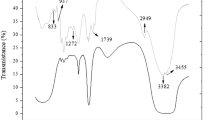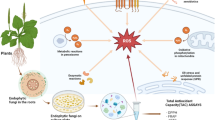Abstract
Medicinal plants and their endophytes are important resources for discovery of natural products. Several previous studies have found a positive correlation between total antioxidant capacity (TAC) and total phenolic content (TPC) of many medicinal plant extracts. However, no information is available on whether such a relationship also exists in their endophytic fungal metabolites. We investigated the relationship between TAC and TPC for 292 morphologically distinct endophytic fungi isolated from 29 traditional Chinese medicinal plants. The antioxidant capacities of the endophytic fungal cultures were significantly correlated with their total phenolic contents, suggesting that phenolics were also the major antioxidant constituents of the endophytes. Some of the endophytes were found to produce metabolites possessing strong antioxidant activities. Several bioactive constituents from the fungal cultures and host plant extracts were identified. This investigation reveals that the metabolites produced by a wide diversity of endophytic fungi in culture can be a potential source of novel natural antioxidants.
Similar content being viewed by others
Literature Cited
Arnold, A. E., Z. Maynard, G. S. Gilbert, P. D. Coley, and T. A. Kursar. 2000. Are tropical fungal endophytes hyperdiverse? Ecology Letters 3:267–274.
—, Z. Maynard, and G. S. Gilbert. 2001. Fungal endophytes in dicotyledonous neotropical trees: Patterns of abundance and diversity. Mycological Research 105:1502–1507.
Cai, Y. Z., Q. Luo, M. Sun, and H. Corke. 2004. Antioxidant activity and phenolic compounds of 112 traditional Chinese medicinal plants associated with anticancer. Life Sciences 74:2157–2184.
Carroll G. 1995. Forest endophytes: Pattern and process. Canadian Journal of Botany 73:S1316-S1324.
Chapela, I. H., O. Petrini, and L. Hagmann. 1991. Monolignol glucosides as specific recognition messengers in fungus-plant symbioses. Physiological and Molecular Plant Pathology 39:289–298.
Cozma, L. S. 2004. The role of antioxidant therapy in cardiovascular disease. Current Opinion in Lipidology 15:369–371.
dos Santos, M. D., P. R. Martins, P. A. dos Santos, R. Bortocan, Y. lamamoto, and N. P. Lopes. 2005. Oxidative metabolism of 5-O-caffeoylquinic acid (chlorogenic acid), a bioactive natural product, by metalloporphyrin and rat liver mitochondria. European Journal of Pharmaceutical Sciences 26:62–70.
Finkel, T., and N. J. Holbrook. 2000. Oxidants, oxidative stress and the biology of ageing. Nature 408:239–247.
Gamboa, M. A., and P. Bayman. 2001. Communities of endophytic fungi in leaves of a tropical timber tree (Guarea guidonia). Biotropica 33:352–360.
Gao, X. M., Z. M. Xu, and Z. W. Li. 2000. Traditional Chinese medicines. People’s Health Publishing House, Beijing, China.
Halliwell, B. 1994. Free radicals, antioxidants, and human disease: Curiosity, cause, or consequence? Lancet 344:721–724.
Hu, C, and D. D. Kitts. 2000. Studies on the antioxidant activity of Echinaceae root extract. Journal of Agricultural and Food Chemistry 48:1466–1472.
Jung, H. A., H. J. Lee, Y. A. Kim, K. E. Park, J. W. Ahn, B. J. Lee, S. G. Moon, and Y. W. Seol. 2004. Antioxidant activity ofArtemisia capillaris Thunberg. Food Science and Biotechnology 13:328–331.
Kähkönen, M. P., A. I. Hopia, H. J. Vuroela, J-P. Rauha, K. Pihlaja, T. S. Kujala, and M. Heinonen. 1999. Antioxidant activity of plant extracts containing phenolic compounds. Journal of Agricultural and Food Chemistry 47:3954–3962.
Kumar, D. S. S., H. Y. Cheung, C. S. Lau, F. Chen, and K. D. Hyde. 2004. In vitro studies of endophytic fungi fromTripterygium wilfordii with antiproliferative activity on human peripheral blood mononuclear cells. Journal of Ethnopharmacology 94:295–300.
Lee, J. C, E. Lobkovsky, N. B. Pliam, G. A. Stroble, and J. Clardy. 1995. Subglutinol A and B: Immunosuppressive compounds from the endophytic fungusFusarium subglutinans. Journal of Organic Chemistry 60:7076–7077.
Li, Y. L, P. P. H. But, and V. E. C. Ooi. 2005. Antiviral activity and mode of action of caffeoylquinic acids fromSchefflera heptaphylla (L.) Frodin. Antiviral Research 68:1–9.
Liu, M., X. Q. Li, C. Weber, C. Y. Lee, J. Brown, and R. H. Liu. 2002. Antioxidant and antiproliferative activities of raspberries. Journal of Agricultural and Food Chemistry 50:2926–2930.
Long, N. E., E. D. Smidmansky, A. J. Archer, and G. A. Strobel. 1998. In vivo addition of telomeric repeats to foreign DNA generates chromosomal DNAs in the taxol-producing fungusPestalotiopsis microspora. Fungal Genetics and Biology 24:335–344.
Luginbuhl, M., and E. Müller. 1980. Endophytische Pilzien den oberirdischen organen von 4 gemeinsam an gleichen Standorten wachsenden Pflanzen (Buxus, Hedera, Ilex, Ruscus). Sydowia 33:185–209.
Mitscher, L. A., H. Telikepalli, E. NeGhee, and D. M. Shankel. 1996. Natural antimutagenic agents. Mutation Research 350:142–143.
Owen, R. W., A. Giacosa, W. E. Hull, R. Haubner, B. Spiegelhalder, and H. Bartsch. 2000. The antioxidant/anticancer potential of phenolic compounds isolated from olive oil. European Journal of Cancer 36:1235–1247.
Petrini O., P. J. Fisher, and L. E. Petrini. 1992. Fungal endophytes of bracken (Pteridium aquilinum) with some reflections on their use in biological control. Sydowia 44:282–293.
Photita, W., S. Lumyong, P. Lumyong, and K. D. Hyde. 2001. Endophytic fungi of wild banana (Musa acuminata) at Doi Suthep Pui National Park, Thailand. Mycological Research 105:1508–1513.
Plowman, T. C, A. Leuchtmanna, C. Blaney, and K. Clay. 1990. Significance of the fungusBalansia cyperi infecting medicinal species ofCyperus (Cyperaceae) from Amazonia. Economic Botany 44:452–462.
Rameazni-Kharazi, P. 2004. Spectroscopic assay of natural antioxidant and anticarcinogenic compounds from two variety of Iranian garlic. Paper presented at ISHS Acta Horticulturae 659: VII International Symposium on Protected Cultivation in Mild Winter Climates: Production, Pest Management and Global Competition. November 2004.
Re, R., N. Pellegrini, A. Proteggente, A. Pannala, M. Yang, and C. A. Rice-Evans. 1999. Antioxidant activity applying an improved ABTS radical cation decolorization assay. Free Radical Biology and Medicine 26:1231–1237.
Rodrigues, K. F. 1994. The foliar endophytes of the Amazonian palmEuterpe oleracea. Mycologia 86:376–385.
Saikkonen, K., S. H. Faeth, M. Helander, and TJ. Sullivan. 1998. Fungal endophytes: A continuum of interaction with host plants. Annual Review of Ecological System 29:319–343.
Sakakibara, H., Y. Honda, S. Nakagawa, H. Ashida, and K. Kanazawa. 2003. Simultaneous determination of all polyphenols in vegetables, fruits, and teas. Journal of Agricultural and Food Chemistry 51:571–581.
Sala, A., N. D. Recio, R. M. Giner, S. Manez, H. Tournier, G. Schinelia, and J. L. Rios. 2002. Antiinflammatory and antioxidant properties ofHelichrysum italicum. Journal of Pharmacy and Pharmacology 54:365–371.
Santos-Buelga, C, and G. Williamson. 2003. Methods in Polyphenol Analysis. Royal Society of Chemistry, Cambridge, UK.
Schulz, B., C. Boyle, S. Draeger, and A. K. Rommert. 2002. Endophytic fungi: A source of novel biologically active secondary metabolites. Mycological Research 106:996–1004.
—, U. Wanke, S. Draeger, and H. J. Aust. 1993. Endophytes from herbaceous plants and shrubs, effectiveness of surface sterilization methods. Mycological Research 97:1447–1450.
Shan, B., Y. Z. Cai, M. Sun, and H. Corke. 2005. Antioxidant capacity of 26 spice extracts and characterization of their phenolic constituents. Journal of Agricultural and Food Chemistry 53:7749–7759.
Song, Y. C, W. Y. Huang, C. Sun, F. W. Wang, and R. X. Tan. 2005. Characterization of Graphislactone A as the antioxidant and free radical-scavenging substance from the culture ofCephalosporium sp 1FBE001, an endophytic fungus inTrachelospermum jasminoides. Biological and Pharmaceutical Bulletin 28:506–509.
Stierle, A., G. A. Strobel, and D. Stierle. 1993. Taxol and taxane production byTaxomyces andreanae, an endophytic fungus of Pacific yew. Science 260:214–216.
Strobel, G., and W. M. Hess. 1997. Glucosylation of the peptide leucinostatin A, produced by an endophytic fungus of European yew, may protect the host from leucinostatin toxicity. Chemistry and Biology 4:529–536.
—, and B. Daisy. 2003. Bioprospecting for microbial endophytes and their natural products. Microbiology and Molecular Biology Reviews 67:491–502.
—, B. Daisy, U. Castillo, and J. Harper. 2004. Natural products from endophytic microorganisms. Journal of Natural Products 67:257–268.
Surveswaran, S., Y. Z. Cai, H. Corke, and M. Sun. 2007. Systematic evaluation of natural phenolic antioxidants from 133 Indian medicinal plants. Food Chemistry 102:938–953.
Tan, R. X., and W. X. Zou. 2001. Endophytes: A rich source of functional metabolites. Natural Product Reports 18:448–459.
Tapiero, H., K. D. Tew, N. Ba, and G. Mathé. 2002. Polyphenols: Do they play a role in the prevention of human pathologies? Biomedicine and Pharmacotherapy 56:200–207.
Wilson, D. 1995. Endophyte—The evolution of a term, a clarification of its use and definition. Oikos 73:274–276.
Wiyakrutta, S., N. Sriubolmas, W. Panphut, N. Thongon, K. Danwiserkanjana, N. Ruangrungsi, and V. Meevootisom. 2004. Endophytic fungi with antimicrobial, anti-cancer, anti-malarial activities isolated from Thai medicinal plants. World Journal of Microbiology and Biotechnology 20:265–272.
Xiao, C. H., S. S. Yang, and X. K. Hong. 2000. Chemistry of traditional Chinese medicines. Shanghai Science and Technology Publishing House, Shanghai, China.
Zheng, W, and S. Y. Wang. 2001. Antioxidant activity and phenolic compounds in selected herbs. Journal of Agricultural and Food Chemistry 49:5165–5170.
Author information
Authors and Affiliations
Rights and permissions
About this article
Cite this article
Huang, WY., Cai, YZ., Xing, J. et al. A potential antioxidant resource: Endophytic fungi from medicinal plants. Econ Bot 61, 14–30 (2007). https://doi.org/10.1663/0013-0001(2007)61[14:APAREF]2.0.CO;2
Accepted:
Issue Date:
DOI: https://doi.org/10.1663/0013-0001(2007)61[14:APAREF]2.0.CO;2




